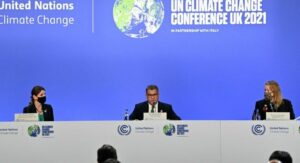Over the first two weeks of November, while world leaders gathered in Glasgow, thousands of activists took to the streets around the world and hundreds of articles, social media posts and opinion pieces were written about COP26 and the future of our planet.

What is the key takeaway of COP26? COP´s results are rather perceived by majority as weak or best relatively moderate and we still urgently need to move beyond commitments towards meaningful, measurable actions. There are however some major points to be taken such as many new investment opportunities in phasing down coal, reducing methane and driving banks towards climate.
In sum the new Cop26 pledges announced on methane, coal, transport, and deforestation could nudge the world 9% closer to a pathway that keeps heating to 1.5C, according to a study by the world’s most respected climate analysis coalition – the Climate Action Tracker. They say the sectoral commitments announced in Glasgow represent potential cuts of 2.2 gigatons of carbon dioxide (total 59 gigatons annually emitted), which is equivalent to the emissions of Germany, Japan and the UK combined. However, this is dependent on governments keeping their climate promises, which almost none have done until now, and it still leaves the world heading towards ever more dangerous levels of heating.
The final COP26 deal has many small wins and a few big game changers, though ultimately falls short of 1.5C. Nations agreed on an interim target of 45% reduction by 2030 and net-zero by 2050. Next year countries should come back with resubmitted emissions reduction plans – though it looks like perfect execution would only likely limit warming to 1.8ºC. This outcome was to be expected and the real significance of COP is the “process of moving from ambition to pledge to NDC to domestic policy to innovation to finance to action monitoring.”
1.Coal phase down. Initially framed as a phase out of coal, China and India disagreed with the clause at the last minute to a phase down. The nuance here could make a big difference in how quickly industrial-heavy countries are forced to phase out coal. From a small win’s perspective, this is coal’s first mention in any COP text.
This of course brings opportunity to accelerate the deployment of renewables, energy storage solutions and grid flexibility.
2. US-China deal. The carbon superpowers issued a joint declaration on collaborating to cut emissions over the next decade. It primes the countries to “develop additional measures to enhance methane emission control,” welcome the Glasgow Leaders’ Declaration on Forests and Land Use, and recall “their respective commitments regarding the elimination of support for unabated international thermal coal power generation.”
3.Methane pledge. 100+ countries committed to reduce emissions 30% by 2030. While the reduction isn’t great, a short-term reduction of methane can have a significant emissions impact.
4.Carbon-trading rules. For the first time, there are now international rules for carbon trading. These long-awaited standards create the foundation for establishing a robust, global carbon trading market that consolidates and harmonizes current bespoke credit systems. Rules set goalposts for how the currently fragmented landscape of voluntary and regulatory carbon offset markets should act and reduce the viability of low-quality offsets.
5.Deforestation. More than 100 countries, representing 85% of the world’s forests, agreed to end deforestation by 2030. The pact includes some of the largest culprits, including Brazil, Russia, and China. The pledge, however, has already seen individual countries wavering or backtracking (e.g., Indonesia).
6.Financial institutions. The former Bank of England Governor Mark Carney whipped banks, investors, and insurers into committing $130T in sustainable investing assets and getting to net zero by 2050. Despite the 450+ firms on the list, his posse failed to include the major Chinese banks which are the primary financiers of coal.
7. Climate aid. Developed countries previously committed $100B per year to fund poorer countries’ clean development, but barely a penny has left their pockets. At this year’s COP, some countries like India refused to participate in negotiations without $1.3T of emissions reparations. COP text left off here to properly set up a mechanism for providing financing for countries struck by catastrophic climate events.
To Sum up now that COP26 has come to an end, it’s time to get to work. Looking for ways how your business can take action? It’s our job to help.




